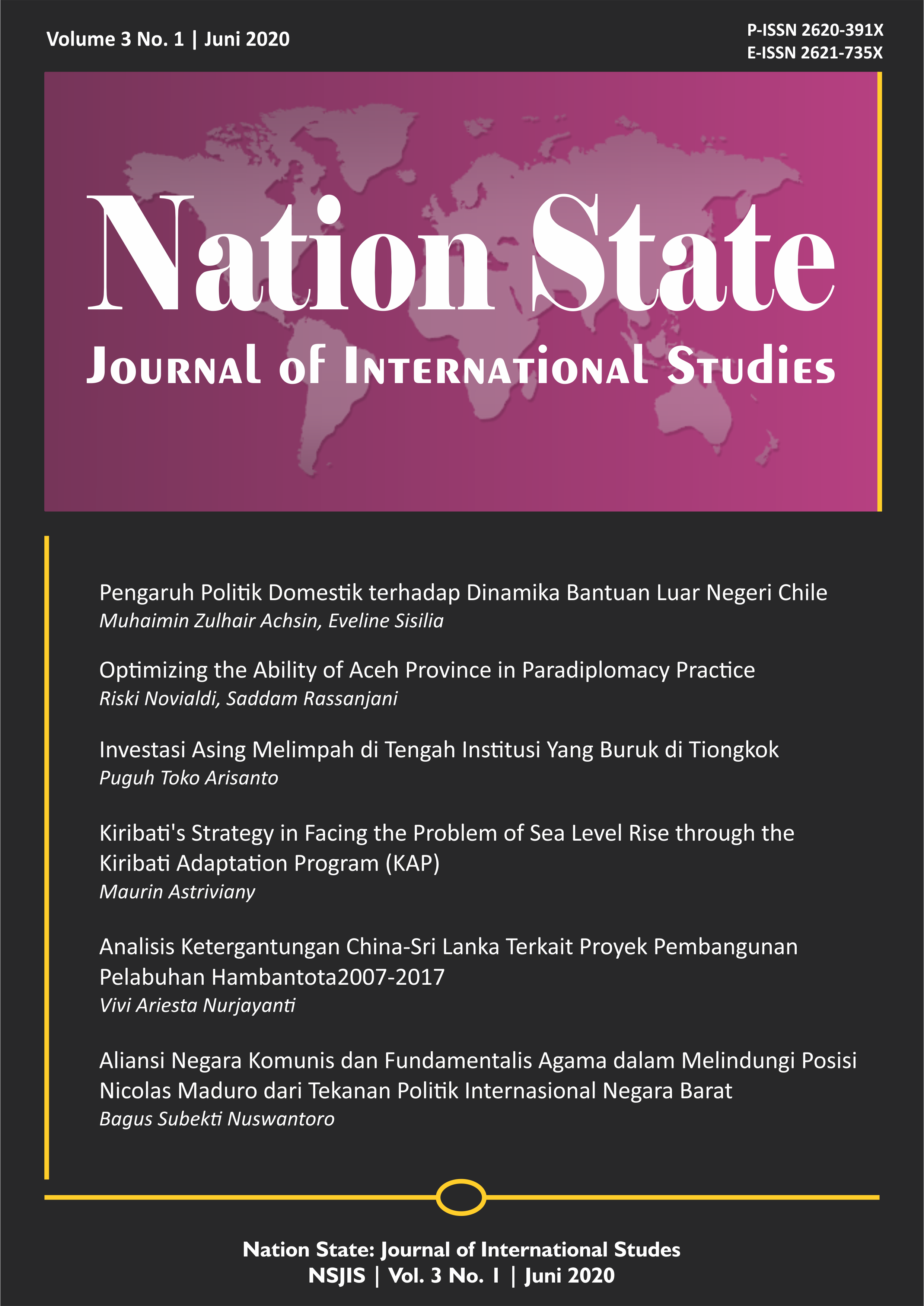Analisis Ketergantungan China-Sri Lanka dalam Proyek Pembangunan Pelabuhan Hambantota Tahun 2007-2017
DOI:
https://doi.org/10.24076/NSJIS.2020v3i1.195Keywords:
Debt, Trap, Belt, Road, Initiative, Hambantota, China-SrilankaAbstract
The purpose of this research is that the reader can find out the problem of Sri Lanka's dependence on China in the Hambantota Port development project which ultimately ended up as a debt trap. In this research authors used qualitative research methods. And from the results of research that has been done, it is found that basically the cooperation carried out by China and Sri Lanka is a collaboration between hegemon countries and third world countries. Debt trap diplomacy itself has close links with other Chinese policies, namely the Belt and Road Initiative, this policy focuses on infrastructure development which includes the construction of railroad networks, the construction of roads to ports located in the territories of other countries and has a strategic position and will good impact for the achievement of Chinese interests in realizing the "new Silk Road". Sri Lanka proposed cooperation to build the port of Hambantota with the aim of helping to improve Sri Lanka's economy. Cooperation that is expected to have a positive impact on Sri Lanka actually brings disaster, because it leads to a debt trap that makes Sri Lanka must hand over the port of Hambantota to the China’s government.
References
Amalia, R. (2016). Kebijakan Politik Luar Negeri Republik Rakyat China di Kawasan Asia Selatan Dan Dampaknya Dibidang Politik Dan Militer. Skripsi. Fakultas Ilmu Sosial dan Ilmu Politik: Universitas Hassanuddin.
Bajo, C.Z. & Roelants, B. (2011) Capital and The Debt Trap-Learning From Cooperatives In The Global Crisis. United Kingdom: Palgrave Macmillan.
BBC Asia. (2019) Mahinda Rajapaksa: Sri Lanka’s Long-Time Leader Back in Seat of Power (Online). Available at: https://www.bbc.com/news/world-asia-24918281 (Accessed: 1 May 2020).
Behuria, A. K. (2018) “How Sri Lanka Walked into a Debt Trap, and the Way Out.” Strategic Analysis, 42(2), pp. 168-178. Available at: https://www.tandfonline.com/doi/abs/10.1080/09700161.2018.1439327?journalCode=rsan20 (Accessed: 1 May 2020).
Brautigam, D. (2019) “Is China's Development Diplomacy in Horn of Africa Transforming into Debt-Trap Diplomacy? An Evaluation”, Area Development and Policy, 5(1). Available at: https://www.researchgate.net/publication/337816614_A_critical_look_at_Chinese_'debt-trap_diplomacy'_the_rise_of_a_meme. (Accessed: 1 May 2020).
Budiman, A. (1995). Teori Pembangunan Dunia Ketiga. Jakarta: Gramedia Pustaka Utama.
Chatzky, A. & McBridge, J. (2020) Massive Belt and Road Initiative (Online). Available at: https://www.cfr.org/backgrounder/chinas-massive-belt-and-road-initiative (Accessed: 26 April 2020).
CNN Indonesia. (2018) Kebijakan Belt and Road China Sebabkan Utang (Online). Available at: https://www.cnnindonesia.com/ekonomi/20180902164934-92-326974/kebijakan-belt-and-road-china-sebabkan-utang-besar (Accessed: 26 April 2020).
Fernanda, C. (2018) Kenapa Pemerintah Membutuhkan Utang Luar Negeri? (Online). Available at: https://www.kompasiana.com/claricaf/5cf0e93b18ffee7f2b10987b/kenapa-pemerintah-membutuhkan-utang-luar-negeri (Accessed: 1 May 2020).
Kasnawi, M. T., & Ramli, A. T. (2015) Pembangunan Masyarakat Desa dan Kota (Online). Available at: http://repository.ut.ac.id/4281/1/IPEM4542-M1.pdf (Accessed: 6 May 2020).
KEMLU RI. (t.t) Profil Sri Lanka (Online). Available at: https://kemlu.go.id/colombo/id/pages/sri-lanka/1913/etc-menu (Accessed: 26 April 2020).
Moramudali, U. (2019) Is Srilanka Really a Victim of China’s ‘Debt Trap’? (Online). Available at: https://thediplomat.com/2019/05/is-sri-lanka-really-a-victim-of-chinas-debt-trap/ (Accessed: 6 May 2020).
Nurjannah. (2020) Kerja Sama Pembangunan Infrastruktur Sri Langka dengan Tiongkok (Online). Available at: https://www.kompasiana.com/nurjannah789/5e290a89d541df2b983ae5b2/kerjasama-pembangunan-infrastruktur-sri-langka-dengan-tiongkok-studi-kasus-lepasnya-pelabuhan-hambatota?page=all (Accessed: 1 May 2020).
Perera, N. (2016) “China’s One Belt One Road Initiative: Implications for Sri Lanka”, Education, 8(28). Available at: http://www.ips.lk/images/docs/news/ips_media_pdf/2016/June%202016/The%20Island_23June2016.pdf. (Accessed: 29 April 2020).
Putera, I.G.N.A.P., Fasisaka, I., & Prameswari, A. A. A. I. (2019) “Kepentingan Tiongkok Dalam Akuisisi Pelabuhan Hambantota Sri Lanka”, Jurnal Hubungan Internasional, 1(1). Available at: https://ojs.unud.ac.id/index.php/hi/article/view/47631 (Accessed: 26 April 2020).
Sautman, B., & Hairong, Y. (2019) The Truth About Sri Lanka’s Hambantota Port, Chinese ‘Debt Traps’ and ‘Asset Seizures (Online). Available at: https://www.scmp.com/comment/insight-opinion/article/3008799/truth-about-sri-lankas-hambantota-port-chinese-debt-traps (Accessed: 6 May 2020).
Setyanti, W. & Mugasejati, N. P. (2018) China's Debt-Trap Diplomacy" Di Era Xi Jinping Studi Kasus:'Kekalahan'sri Lanka Dalam Proyek Hambantota. Disertasi. Yogyakarta: Fisipol Universitas Gadjah Mada.
Ulber, S. (2012) Metode Penelitian Sosial. Bandung: Refika Aditama.
Var, V., & Po, S. (2017) Cambodia, Sri Lanka and the China Debt Trap (Online). Available at: https://bandapost.org/wp-content/uploads/pdf/Dec%20Cambodia%20and%20Sri%20Lanka%20on%20China's%20debt%20trap.pdf (Accessed: 1 May 2020).
Downloads
Published
Issue
Section
License
Copyright (c) 2020 Vivi Ariesta Nurjayanti

This work is licensed under a Creative Commons Attribution-NonCommercial 4.0 International License.


